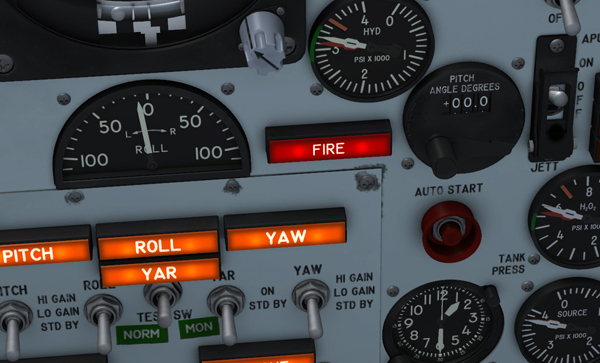
Fire-warning light.
In case of a fire or explosion, the procedures given in the following paragraphs should be accomplished. However, an important factor in determining the course of action to be taken depends on the effect the fire or explosion has on the flight control systems. Since a failure of the aerodynamic flight control system could occur as a result of the fire or explosion, a careful check of the aerodynamic system should be made to determine whether a safe landing can be made.
Engine Fire
If the fire-warning light [47, fig. 5-1] comes on or if there are other indications of fire, proceed as follows:
- Helium release selector switch [1, fig. 5-1] – Check AUTO. With the helium release selector switch at AUTO when the fire-warning system is activated, the engine is automatically shut down and the engine compartment purged. If automatic shutdown is successful, proceed to step 3. However, if the engine fails to shut down, proceed to step 2.
- Shut down engine:
- Engine master switch [63, fig. 5-1] – OFF. Moving the engine master switch to OFF purges the engine with helium for approximately 17 seconds.
- Helium release selector switch [1, fig. 5-1] – ON.
- Throttle [12, fig. 5-4] – OFF.
- Igniter idle switch [53, fig. 5-1] – OFF.
- If fire cannot be confirmed, land as soon as possible. If fire cannot be confirmed or if it goes out, establish controllability and jettison propellants en route to the nearest available base where a landing can be made. Obtain assistance from chase pilot if possible. Reconfirm controllability before descent below safe ejection altitude.
- If fire is confirmed or if aerodynamic control is lost – Eject.
Electrical Fire
In case of an electrical fire, attempt to isolate fire by moving circuit breakers off one at a time. Allow sufficient time for the indication of fire to cease. When source of fire is found, leave the affected circuit de-energized, and restore power to remaining circuits.
H2O2 Compartment Overheat
If the "H2O2 COMP HOT" [58, fig. 5-1] light comes on, immediately notify the carrier pilot that an X-15 emergency is in progress. Then prepare for an emergency launch (refer to "Emergency Launch"), in case an emergency launch becomes necessary.
APU H2O2 Overheat
If the APU "H2O2 HOT" [28, fig. 5-1] light comes on, immediately notify the carrier pilot that an X-15 emergency is in progress. Determine which APU system is overheated and proceed as follows:
- APU switch – OFF. The APU system that is overheated must be shut down.
- APU switch – JETT. Maximum time for jettison is approximately 27 seconds. Launch operator and chase pilot will monitor jettison pattern.
- Prepare for emergency launch. Refer to "Emergency Launch".
APU H2O2 Low Caution
If the "H2O2 LOW" [31, fig. 5-1] caution light comes on, notify the carrier pilot that an X-15 emergency is in progress. Shut down affected APU and prepare for an aborted launch.
- APU switch – OFF. The affected APU system must be shut down.
- APU switch – JETT. Maximum time for jettison is approximately 27 seconds. Launch operator and chase pilot will monitor jettison pattern.
- Prepare for an aborted launch.
APU Compartment Overheat
If the "APU COMP HOT" [29, fig. 5-1] light comes on, immediately notify the carrier pilot that an X-15 emergency is in progress. Determine which APU system is overheated and proceed as follows:
- APU switch – OFF. The APU system that is overheated must be shut down.
- APU switch – JETT. Maximum time for jettison is approximately 27 seconds. Launch operator and chase pilot will monitor jettison pattern.
- Prepare for emergency launch. Refer to "Emergency Launch".
